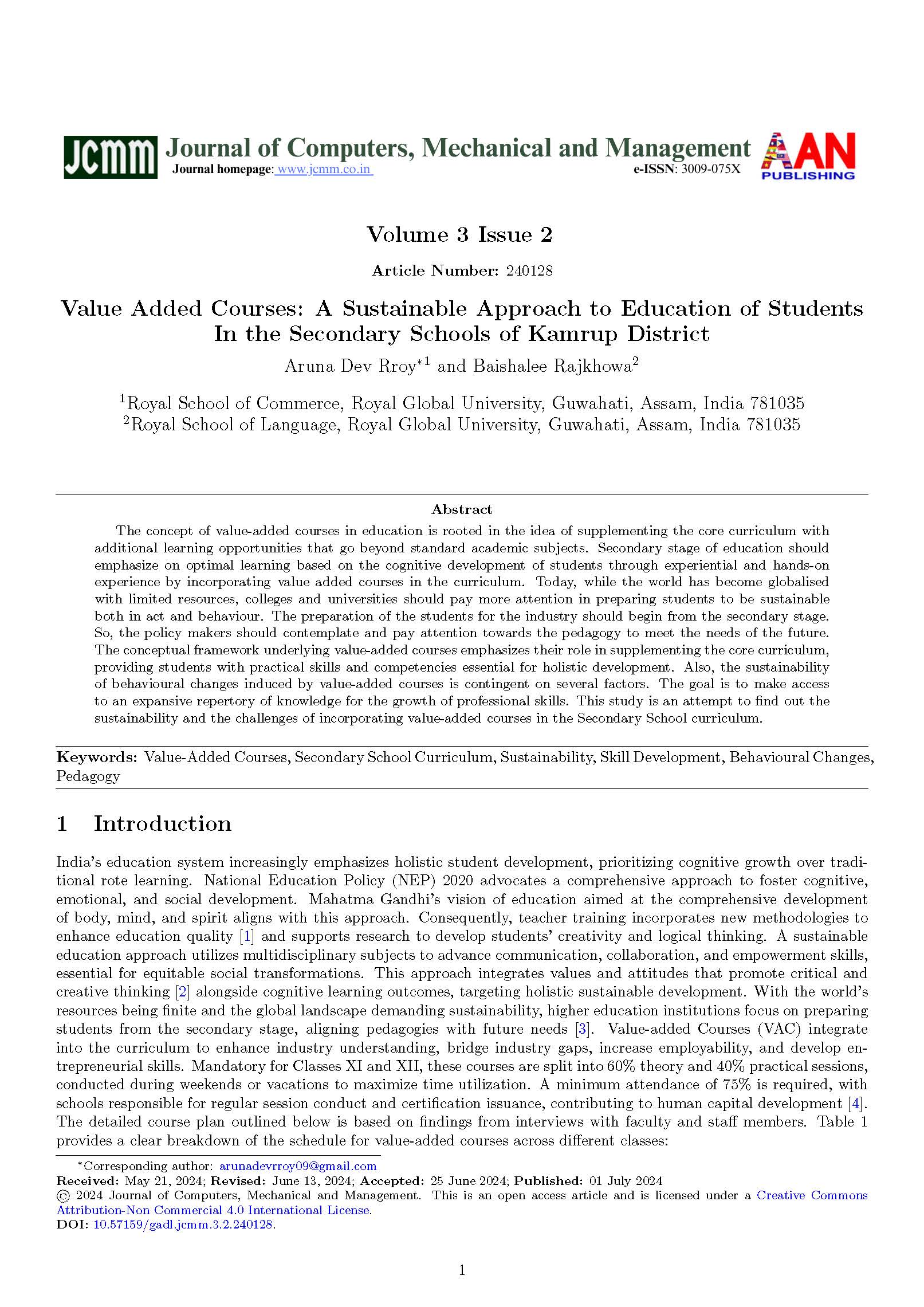Enhancing Secondary Education in Kamrup District Through Value-Added Courses
A Sustainable Approach
DOI:
https://doi.org/10.57159/gadl.jcmm.3.2.240128Keywords:
Value-Added Education, Secondary Education, Sustainable Learning, Skill Enhancement, Educational PedagogyAbstract
The concept of value-added courses in education is rooted in supplementing the core curriculum with additional learning opportunities beyond standard academic subjects. The secondary stage of education should emphasize optimal learning based on students' cognitive development through experiential and hands-on experience by incorporating value-added courses in the curriculum. Today, while the world has become globalized with limited resources, colleges and universities should pay more attention to preparing students to be sustainable (McCaffrey & Hamilton, 2007) both in act and behavior. The preparation of the students for the industry should begin from the secondary stage. So, the policymakers should contemplate and pay attention to the pedagogy to meet future needs. The conceptual framework underlying value-added courses emphasizes their role in supplementing the core curriculum, providing students with practical skills and competencies essential for holistic development. Also, the sustainability of behavioral changes induced by value-added courses is contingent on several factors. The goal is to gain access to an expansive repertory of knowledge to grow professional skills. This study attempts to determine the sustainability and the challenges of incorporating value-added courses in the Secondary School curriculum.
References
X. A. Newton, L. Darling-Hammond, E. Haertel, and E. Thomas, “Value-added modeling of teacher effectiveness: An exploration of stability across models and contexts,” Education Policy Analysis Archives, vol. 18, p. 23, 2010.
H. Rose and J. R. Betts, “The effect of high school courses on earnings,” Review of Economics and Statistics, vol. 86, no. 2, pp. 497–513, 2004.
D. F. McCaffrey and L. S. Hamilton, Value-Added Assessment in Practice: Lessons from the Pennsylvania Value-Added Assessment System Pilot Project, vol. 506. Rand Corporation, 2007.
R. Das and S. Singha, “Role of education and training in formation of human capital and creation of entrepreneurial environment in Assam—a case study of Kamrup district,” International Journal of Academic Research in Business and Social Sciences, vol. 2, no. 3, pp. 2222–6990, 2012.
S. Banerjee, P. Upadhyay, and R. M. Punekar, “Teaching design for sustainability for socioeconomic ecosystems—three case studies,” in Research into Design for a Connected World: Proceedings of ICoRD 2019 Volume 2, pp. 935–946, Springer Singapore, 2019.
Ministry of Micro, Small and Medium Enterprises, “MSME - development institutes,” 2006. Retrieved from https://web.archive.org/web/20100312035006/http://msme.gov.in/welcome.html, accessed 8 December 2023.
P. E. Barton, Educating the Whole Child: Improving School Climate to Support Student Success. Princeton, NJ: Educational Testing Service, 2008.
R. J. Simons et al., “Developing creative problem-solving skills in college and career readiness: A thematic review,” Journal of Creativity in Mental Health, vol. 14, no. 1, pp. 1–13, 2019.
C. Adelman, The Toolbox Revisited: Paths to Degree Completion from High School Through College. Washington, D.C.: U.S. Department of Education, 2006.
H. Gardner, Five Minds for the Future. Harvard Business Review, 2007.
S. Hidi and K. A. Renninger, “The four-phase model of interest development,” Educational Psychologist, vol. 41, no. 2, pp. 111–127, 2006.
Y. Mochizuki and Z. Fadeeva, “Regional centres of expertise on education for sustainable development (RCEs): An overview,” International Journal of Sustainability in Higher Education, vol. 9, no. 4, pp. 369–381, 2008.
J. Fien, “Advancing sustainability in higher education: Issues and opportunities,” International Journal of Sustainability in Higher Education, vol. 3, no. 3, pp. 243–253, 2002.
R. Louv, Last Child in the Woods: Saving Our Children from Nature-Deficit Disorder. Algonquin Books, 2008.
M. Barth and J. Timm, “Higher education for sustainable development: Students’ perspectives on an innovative approach to educational change,” Journal of Social Science, vol. 7, no. 1, pp. 13–23, 2011.
T. Brudermann, R. Aschemann, M. Füllsack, and A. Posch, “Education for sustainable development 4.0: Lessons learned from the University of Graz, Austria,” Sustainability, vol. 11, no. 8, p. 2347, 2019.
P.-W. Hsiao and C.-H. Su, “A study on the impact of STEAM education for sustainable development courses and its effects on student motivation and learning,” Sustainability, vol. 13, no. 7, p. 3772, 2021.

Downloads
Published
How to Cite
Issue
Section
License
Copyright (c) 2024 Journal of Computers, Mechanical and Management

This work is licensed under a Creative Commons Attribution-NonCommercial 4.0 International License.
The Journal of Computers, Mechanical and Management applies the CC Attribution- Non-Commercial 4.0 International License to its published articles. While retaining copyright ownership of the content, the journal permits activities such as downloading, reusing, reprinting, modifying, distributing, and copying of the articles, as long as the original authors and source are appropriately cited. Proper attribution is ensured by citing the original publication.





